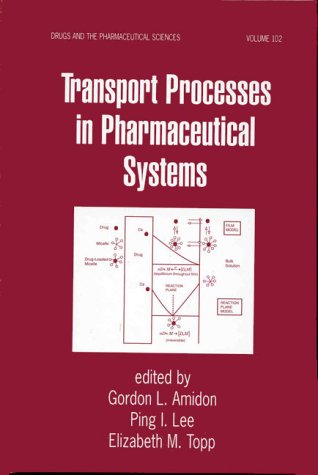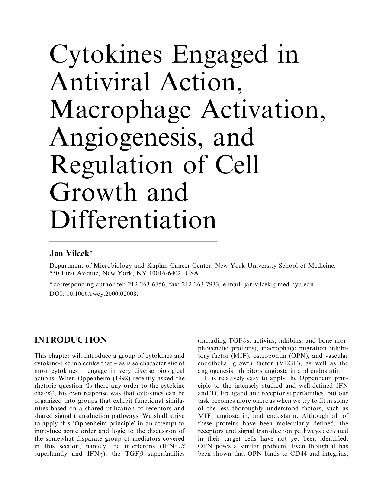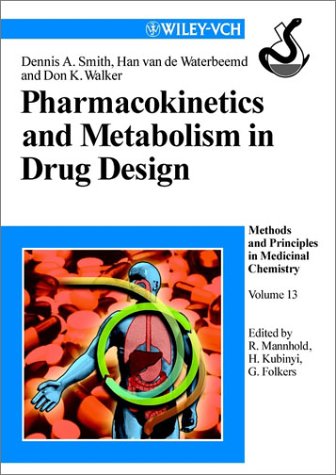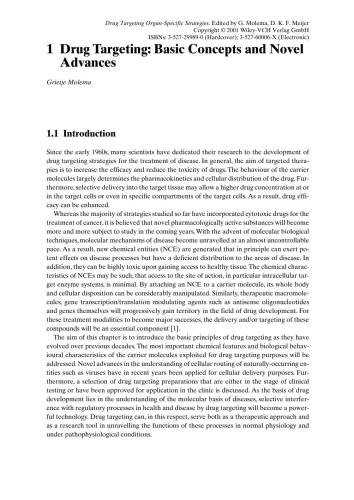Gordon Amidon, Ping Lee, Elizabet Topp9780824766108, 0-8247-6610-5
Table of contents :
Transport Processes in Pharmaceutical Systems……Page 2
Preface……Page 11
Contributors……Page 15
Contents……Page 13
Contents……Page 0
A. Thermodynamic Basis for Mass Transfer……Page 18
B. The Systems Approach to Mass Transfer Problems……Page 20
II. CONVECTION……Page 22
A. Stirred Tank Models……Page 23
B. Plug Flow Models……Page 25
C. Complex Flows……Page 27
III. DIFFUSION……Page 29
1. Convective Diffusion Approach……Page 32
2. Nonequilibrium Thermodynamics Approach……Page 33
1. Gradients in Electrical Potential……Page 34
2. Combined Heat and Mass Transfer……Page 35
V. SUMMARY……Page 36
VI. GLOSSARY OF TERMS……Page 37
REFERENCES……Page 38
I. INTRODUCTION……Page 40
A. Fick’s First Law……Page 41
B. Fick’s Second Law……Page 42
III. CONVECTION AND GENERALIZED MASS BALANCE EQUATIONS……Page 44
A. Steady Diffusion Across a Thin Film……Page 46
B. Steady Diffusion Across a Membrane……Page 48
C. Steady Diffusion Across a Membrane with Aqueous Diffusion Layers……Page 50
D. Steady Diffusion in Parallel……Page 53
E. Unsteady Diffusion into a Semi- Infinite Membrane……Page 54
F. Unsteady Diffusion Across a Membrane……Page 58
G. Effect of Reaction on Membrane Diffusion……Page 60
V. DIFFUSION IN A CYLINDER……Page 62
VI. DISSOLUTION OF A SPHERE……Page 64
VII. INTRINSIC DISSOLUTION……Page 66
REFERENCES……Page 69
A. Compartmental Models……Page 71
B. Physiologically Based Pharmacokinetic Models……Page 73
A. Compartmental Models……Page 76
B. Physiologically Based Pharmacokinetic Models……Page 80
C. Distributed Parameter Models……Page 89
A. Compartmental Models……Page 90
1. Organ Blood Flows and Volumes……Page 92
2. Partition Coefficients……Page 93
3. Mass Transfer Coefficients……Page 94
4. Clearances……Page 95
6. Miscellaneous……Page 96
8. Model Validation……Page 97
C. Distributed Parameter Models……Page 98
REFERENCES……Page 99
I. INTRODUCTION……Page 103
1. Miscible Phases……Page 104
2. Immiscible Phases……Page 107
1. Miscible Liquid Phases……Page 108
2. Immiscible Liquid Phases……Page 110
2. Immiscible Phases……Page 111
D. Liquid/ Membrane/ Semisolid Interface……Page 112
1. Mass Transfer from Constant Surface Area Solids……Page 113
2. Mass Transfer from Finely Divided Drug Particles……Page 114
F. Liquid/ Cultured Cell Interface……Page 115
A. Diffusion Coefficients……Page 116
B. Mass Transport Quantities……Page 118
V. ERROR ANALYSIS AND METHOD VALIDATION……Page 119
REFERENCES……Page 122
I. INTRODUCTION……Page 125
II. DISSOLUTION OF ACIDIC AND BASIC DRUGS IN UNBUFFERED MEDIA……Page 126
III. DISSOLUTION OF ACIDIC AND BASIC DRUGS INTO BUFFERED SOLUTION……Page 133
IV. DISSOLUTION OF MULTICOMPONENT SOLIDS……Page 135
V. DISSOLUTION OF POORLY SOLUBLE COMPOUNDS IN SURFACTANT SOLUTIONS……Page 140
A. Film Equilibrium Model……Page 141
B. Reaction Plane Model……Page 144
VI. DISSOLUTION OF POORLY SOLUBLE DRUGS IN EMULSION SYSTEMS……Page 145
VII. PARTICLE DISSOLUTION……Page 148
A. Boundary Layer Thickness……Page 149
B. Mathematical Models for Particle Dissolution: Monodisperse Populations……Page 150
C. Mathematical Models for Particle Dissolution: Polydisperse Populations……Page 153
VIII. CONCLUSIONS……Page 155
REFERENCES……Page 157
II. GASTROINTESTINAL EPITHELIA — STRUCTURE AND FUNCTION……Page 163
A. Precellular Barriers……Page 169
B. Lipid Barriers, Transcellular Partition Path, Surface Area……Page 170
C. Paracellular Transport — Equivalent Pore and Circuit Theory……Page 177
D. Membrane Transport Facilitators: Carrier, Channel, and Endosomal Proteins……Page 181
A. Kinetics of Cellular Diffusion……Page 182
B. Active and Facilitated Transport……Page 183
C. Mediated Transport Kinetics: Saturation and Inhibitors……Page 184
D. Exchange Phenomena: Cis and Trans Effects……Page 186
A. Ion Gradients: Solute – Solute Coupling……Page 188
B. Osmotic Gradients: Solute – Solvent Coupling……Page 190
D. The Role of Metabolism and Intestinal Secretion: Reaction – Transport Coupling……Page 191
VI. TRANSPORT ADAPTATION AND REGULATION……Page 192
VII. ISOLATED EXPERIMENTAL METHODS OF STUDY AND CORRELATIONS WITH IN VIVO ABSORPTION……Page 193
VIII. SUMMARY……Page 195
REFERENCES……Page 196
A. Introduction……Page 201
B. Ester Derivatives as Prodrugs……Page 202
C. Oral Prodrugs for NEH Acidic Compounds……Page 207
D. Prodrugs for Amines……Page 209
E. Enzyme Prodrugs Targeting Specific Enzymes……Page 211
F. Amino Acid or Peptidyl Derivatives as Prodrugs……Page 212
A. Introduction……Page 218
C. The Michaelis – Menten Equation……Page 219
D. Enzymes in General……Page 221
1. The Luminal and Mucosal Cell Enzymes……Page 222
F. Intestinal Mucosal Peptidases……Page 223
A. Introduction……Page 226
B. Modeling Prodrugs and a Targeted Drug Delivery System……Page 227
REFERENCES……Page 229
I. INTRODUCTION……Page 235
A. General Background on Passive Transport……Page 236
B. Selection of a Transport System and Parameters to Consider……Page 241
A. Steady-State Kinetics Under Sink Conditions……Page 249
B. Steady- State Kinetics Under Non- Sink Conditions……Page 252
C. Permeability Coefficients……Page 254
A. Morphology of the Paracellular Route……Page 255
1. Molecular Restricted Diffusion Within an Electrostatic Field of Force……Page 258
2. Barriers in Series: Tight Junction and Lateral Space……Page 261
1. Hydrophilic Extracellular Permeants……Page 262
2. Pore Size Changes and Pharmacological Perturbation……Page 267
3. Barrier Assessment of the Tight Junction and Lateral Space……Page 270
4. Correlation of Paracellular Permeability with Transmonolayer Electrical Resistance……Page 274
A. Permeability Coefficient……Page 277
B. Applications……Page 279
A. Permeability Coefficients……Page 280
1. Steroids……Page 282
2. Peptides……Page 290
3. Influence of the Perturbed Paracellular Route……Page 293
A. Permeability Coefficients……Page 295
B. Application……Page 297
A. Biophysical Model Description……Page 304
B. Interrelation of Fluxes and Extent of Metabolism……Page 307
C. Donor Disappearance and Receiver Appearance Kinetics……Page 308
D. Applications……Page 310
A. Introduction……Page 313
B. Influx Kinetics and the Apical Membrane Domain……Page 316
C. Efflux Kinetics from the Apical Membrane Domain……Page 320
D. Biophysical Model for Transcellular Flux Kinetics……Page 323
IX. USE OF IN VITRO MONOLAYER STUDIES TO PREDICT RESULTS IN VIVO……Page 325
REFERENCES……Page 329
I. INTRODUCTION……Page 333
1. Cornea……Page 335
2. Conjunctiva……Page 336
B. Electrophysiology……Page 337
III. PERMEABILITY BARRIERS IN THE CORNEA AND THE CONJUNCTIVA……Page 357
A. Conventional Means……Page 361
1. Activation of Ion-Dependent Cotransport Processes……Page 366
2. Modulation of Extra- and Intracellular Ca2 Levels……Page 368
4. Modulation of Cl Channels……Page 370
REFERENCES……Page 375
I. INTRODUCTION……Page 391
A. pH-Partition Hypothesis……Page 392
B. Absorption Potential Concept……Page 394
A. Macroscopic Mass Balance Approach……Page 395
B. Microscopic Mass Balance Approach……Page 402
A. Dispersion Model……Page 405
B. Mixing Tank Model……Page 407
C. Compartmental Absorption and Transit Model……Page 409
V. SUMMARY……Page 416
VI. NOTATION……Page 417
REFERENCES……Page 418
I. INTRODUCTION……Page 424
II. FUNDAMENTAL CONCEPTS……Page 425
A. One-Compartment Systems……Page 428
B. Two- Compartment Systems……Page 446
C. Pulsatile Systems……Page 452
REFERENCES……Page 454
I. INTRODUCTION……Page 458
A. Frames of Reference……Page 459
B. Diffusion Coefficients……Page 460
C. Fickian Sorption……Page 461
D. Fickian Permeation……Page 462
III. DIFFUSION IN POLYMER – PENETRANT SYSTEMS……Page 464
A. Free Volume Theories……Page 465
B. Glassy State and Anomalous Diffusion……Page 470
A. Swelling and Case II Transport……Page 473
B. Diffusion in Swollen Gels……Page 474
REFERENCES……Page 480
I. INTRODUCTION……Page 485
A. Monomer Polymerization……Page 488
1. Types of Gels……Page 497
2. Chemical Cross-Linking……Page 500
3. Radiation Cross-Linking……Page 501
4. Physical Cross-Linking……Page 502
C. Other Techniques for Hydrogel Synthesis……Page 504
A. Equilibrium Swelling Degree……Page 505
B. Swelling Kinetics……Page 520
C. Hydrogel Permeability……Page 531
1. Biocompatibility……Page 540
2. Biodegradability……Page 542
IV. SUMMARY……Page 544
REFERENCES……Page 545
II. pH- MODULATED SYSTEMS……Page 559
III. PHOTOSENSITIVE POLYMERIC MEMBRANES……Page 564
IV. TEMPERATURE- SENSITIVE HYDROGELS……Page 568
V. ELECTRIC CURRENT – SENSITIVE POLYMERS……Page 577
REFERENCES……Page 583
I. INTRODUCTION……Page 586
II. CRYSTALLINITY AND AMORPHOUS MATERIALS……Page 587
III. PHASE TRANSITIONS……Page 598
C. Dielectric Analysis……Page 601
IV. POLYMORPHISM……Page 602
V. HYDRATION……Page 610
VI. CONCLUSIONS……Page 617
REFERENCES……Page 618
I. OVERVIEW OF THE FREEZE- DRYING PROCESS……Page 622
A. Mass Transfer and Resistance……Page 625
B. Heat Transfer Coefficients and Temperature Differences……Page 628
C. Coupling Between Heat and Mass Transfer: Process Control……Page 630
A. Kinetic Theory, Collisions, and Gas Pressure……Page 635
B. Distribution of Velocity: The Maxwell – Boltzmann Distribution……Page 637
C. Calculation of Average Quantities for a Gas……Page 642
1. The Intensity Equation……Page 644
2. The Knudsen Cosine Law……Page 647
E. Mean Free Path……Page 648
F. Flow Through an Orifice: Knudsen Effusion……Page 650
G. Rates of Sublimation and Evaporation……Page 652
H. Viscosity of Gases and Slip Flow……Page 655
1. General Principles……Page 662
2. Free Molecular Flow……Page 663
3. Transition Flow in a Cylindrical Tube……Page 666
1. Gases at High Pressure……Page 670
2. Free Molecular Flow Heat Transfer……Page 673
3. Heat Conductivity in Transition Flow……Page 676
A. Blackbody Radiation……Page 678
B. Real Surfaces……Page 680
2. Resistance of Dried Product……Page 683
1. Special Cases of Radiative Heat Transfer in Freeze Drying……Page 689
2. Mechanisms of Heat Transfer in Freeze Drying……Page 692
3. Variations in Heat Transfer……Page 693
ADDITIONAL REFERENCES……Page 697
A. Hygroscopic Materials……Page 698
B. Empirical Approaches to Moisture Uptake……Page 699
II. VAPOR – LIQUID EQUILIBRIA……Page 700
III. HEAT CONDUCTION……Page 702
A. Heat Conduction in Rectangular Coordinates……Page 704
B. Heat Conduction in Spherical Coordinates……Page 706
IV. HEAT TRANSPORT CONTROLLED MOISTURE SORPTION ( PURE WATER ATMOSPHERE)……Page 708
A. Heat Flux Caused by Moisture Uptake in One Dimension……Page 711
B. Heat Transport Limited Moisture Uptake in Spherical Coordinates……Page 712
V. MASS TRANSPORT CONTROLLED MOISTURE SORPTION……Page 714
A. Mass Transport Limited Moisture Uptake in One Dimension……Page 716
VI. COMBINED MASS AND HEAT TRANSPORT CONTROLLED MOISTURE SORPTION……Page 718
VII. DELIQUESCENT MATERIALS IN POROUS SYSTEMS……Page 720
REFERENCES……Page 723







Reviews
There are no reviews yet.